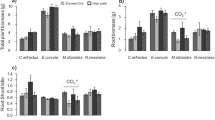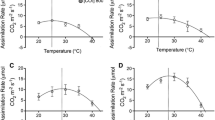Abstract
Previously we examined how limited rooting space and nutrient supply influenced plant growth under elevated atmospheric CO2 concentrations (McConnaughay et al. 1993). We demonstrated that plant growth enhancement under elevated CO2 was influenced more by the concentration of nutrients added to growth containers than to either the total nutrient content per pot or amount or the dimensions of available rooting space. To gain insight into how elevated CO2 atmospheres affect how plants utilize available belowground space when rooting space and nutrient supply are limited we measured the deployment of roots within pots through time. Contrary to aboveground responses, patterns of belowground deployment were most strongly influenced by elevated CO2 in pots of different volume and shape. Further, elevated CO2 conditions interacted differently with limited belowground space for the two species we studied,Abutilon theophrasti, a C3 dicot with a deep taproot, andSetaria faberii, a C4 monocot with a shallow fibrous root system. ForSetaria, elevated CO2 increased the size of the largest region of low root density at the pot surface in larger rooting volumes independent of nutrient content, thereby decreasing their efficiency of deployment. ForAbutilon, plants responded to elevated CO2 concentrations by equalizing the pattern of deployment in all the pots. Nutrient concentration, and not pot size or shape, greatly influenced the density of root growth. Root densities forAbutilon andSetaria were similar to those observed in field conditions, for annual dicots and monocots respectively, suggesting that studies using pots may successfully mimic natural conditions.
Similar content being viewed by others
References
Arp WJ (1991) Effects of source-sink relations on photosynthetic acclimation to elevated CO2. Plant Cell Environ 14:869–875
Bazzaz FA (1990) Response of natural ecosystems to the rising CO2 levels. Ann Rev Ecol Syst 21:167–196
Berntson GM, Woodward FI (1992) The root system architecture and development ofSenecio vulgaris L. in elevated CO2 and drought. Func Ecol 6:324–333
Carmi A, Hesketh JD, Enos WT, Peters DB (1983) Interrelationships between shoot growth and photosynthesis, as affected by root growth restriction. Photosynthetica 17:240–245
Carmi A, Heuer B (1981) The role of roots in control of bean shoot growth. Ann Bot 48:519–527
Chaudhuri UN, Burnett RB, Kirkham MB, Kanemasu ET (1986) Effect of carbon dioxide on sorghum yield, root growth, and water use. Agric Meteorol 37:109–122
Chaudhuri UN, Kirkham MB, Kanemasu ET (1990) Carbon dioxide and water level effects on yield and water use of winter wheat. Agron J 82:637–641
Cornforth IS (1968) Relationships between soil volume used by roots and nutrient accessibility. J Soil Sci 19:291–301
Crabtree RC, Berntson GM (1993) Root architectural responses ofBetula lenta to spatially heterogeneous ammonium and nitrate. Plant Soil (in press)
Curtis PS, Balduman LM, Drake BG, Whigham DF (1990) Elevated atmospheric CO2 effects on belowground processes in C3 and C4 estuarine marsh communities. Ecology 71:2001–2006
Gregory PJ (1988) Growth and functioning of plant roots. In: Wild A (ed) Russell's Soil Conditions and Plant Growth. Eleventh Edition. Longman, London. pp 113–167
Hameed MA, Reid JB, Row RN (1987) Root confinement and its effects on the water relations, growth and assimilate partitioning of tomato (Lycopersicon esculentum Mill). Ann Bot 59:685–692
Hogan KP, Smith AP, Ziska LH (1991) Potential effects of elevated CO2 and changes in temperature on tropical plants. Plant Cell Environ 14:763–778
Idso SB (1991) Comment on “Modelling the seasonal contribution of a CO2 fertilization effect of the terrestrial vegetation to the amplitude increase in atmospheric CO2 at Mauna Loa Observatory” by G.H. Kohlmaier et al. Tellus 43B:338–341
Idso SB, Kimball BA (1991) Downward regulation of photosynthesis and growth at high CO2 levels. No evidence for either phenomenon in three-year study of sour orange trees. Plant Physiol 96:990–992
Jackson LE, Bloom AJ (1990) Root distribution in relation to soil nitrogen availability in field-grown tomatos. Plant Soil 128:115–126
Jarvis PG (1989) Atmospheric carbon dioxide and forests. Philos Trans R Soc London B324:369–392
Kaushal P, Guehl JM, Aussenac G (1989) Differential growth response to atmospheric carbon dioxide enrichment in seedlings ofCedrus atlantica andPinus nigra ssp.Laricio var.Corsicana. Can J For Res 19:1351–1358
Krizek DT, Carmi A, Mirecki RM, Snyder FW, Bunce JA (1985) Comparative effects of soil moisture stress and restricted root zone volume on morphogenetic and physiological responses of soybean [Glycine max (L.) Merr]. J Exp Bot 36:25–38
Lawlor DW, Mitchell RAC (1991) The effects of increasing CO2 on crop photosynthesis and productivity: a review of field studies. Plant Cell Environ 14:807–818
Logsdon SD, Reneau RB, Parker JC (1987) Corn seedling growth as influenced by soil physical properties. Agron J 79:221–224
McConnaughay KDM, Berntson GM, Bazzaz FA (1993) Limitations to CO2-induced growth enhancement in pot studies. Oecologia 94:550–557
Newman EI, Rosalie EA (1973) Uptake of phosphorous and potassium in relation to root growth and root density. Plant Soil 38:49–69
Parrish JAD, Bazzaz FA (1976) Underground niche separation in successional plants. Ecology 57:1281–1288
Reekie EG, Bazzaz FA (1991) Phenology and growth in four annual species grown in ambient and elevated CO2. Can J Bot 69:2475–2481
Richards D, Rowe RN (1977) Effects of root restriction, root pruning and 6-benzylaminopurine on the growth of peach seedlings. Ann Bot 41:729–740
Robbins NS, Pharr DM (1988) Effect of restricted root growth on carbohydrate metabolism and whole plant growth ofCucumis sativus L. Plant Physiol 87:409–413
Russell RS, Goss MJ (1974) Physical aspects of soil fertility—The response of roots to mechanical impedance. Neth J Agric Sci 22:305–318
Strain BR, Cure JD (1985) Direct Effects of Increasing Carbon Dioxide on Vegetation. USDOE, Washington DC
Thomas RB, Strain BR (1991) Root restriction as a factor in photosynthetic acclimation of cotton seedlings grown in elevated carbon dioxide. Plant Physiol 96:627–634
Tschaplinski TJ, Blake TJ (1985) Effects of root restriction on growth correlations, water relations and senescence of alder seedlings. Physiol Plant 64:167–176
Wieland NK, Bazzaz FA (1975) Physiological ecology of three codominant successional annuals. Ecology 56:681–688
Author information
Authors and Affiliations
Rights and permissions
About this article
Cite this article
Berntson, G.M., McConnaughay, K.D.M. & Bazzaz, F.A. Elevated CO2 alters deployment of roots in “small” growth containers. Oecologia 94, 558–564 (1993). https://doi.org/10.1007/BF00566972
Received:
Accepted:
Issue Date:
DOI: https://doi.org/10.1007/BF00566972




